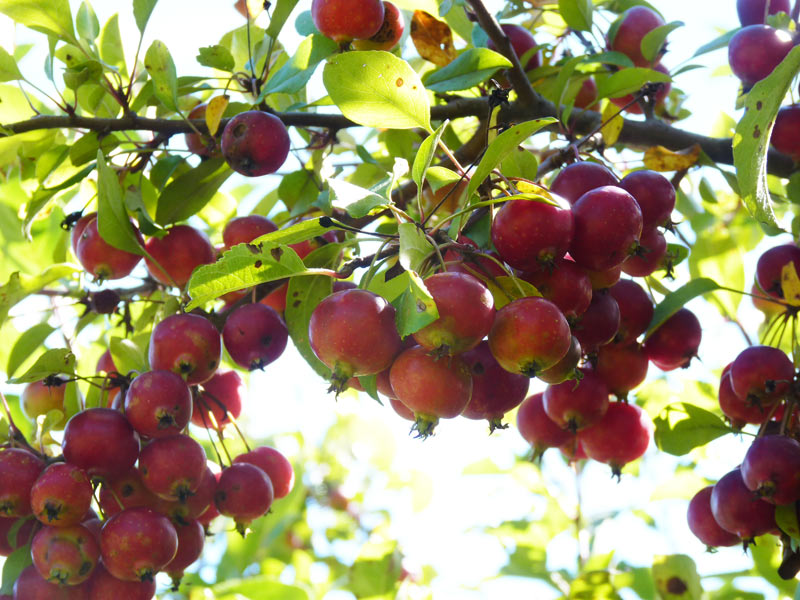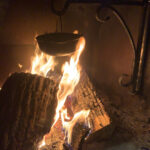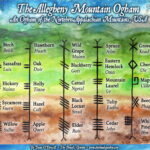A group of people gather in an orchard, the snows quietly falling, the cold brisk and clear. Our voices ring to the heavens, toast is offered to the branches of the tree. We drum, sing, make noise, and scare away any spirits who would seek to harm the orchard’s harvest. We enjoy hot mulled cider and retreat back inside for feasting and community. This is a wassail for the health of the apple trees, an ancient celebration that is now very much part of my yearly wheel of the year (and one that I’ve described in some depth on this blog earlier this year and a few years ago). This is one of many rich traditions that we can engage in in honoring the land and living an earth-based path. In my last post, we explored how druids in various ecosystems might adapt the UK-based wheel of the year (a set of seasonal holidays) to their local ecosystems and cultural norms. Today, we continue this by exploring how to take your ecoregional wheel of the year you are developing and turn it into a set of rituals, observances, and activities.
Developing Localized Rituals, Observances, and Activities

After some research and reflection, perhaps you’ve started to put together your own wheel of the year (see my last post) that includes a series of astronomical observances combined with regional and local observances. And you look at your wheel and think, “now what?” The most immediate thing that comes to mind is that you have to do some kind of formal ritual to celebrate, and that is certainly a possibility. Today, I’d like to suggest that there are at least three ways you can celebrate these events on your wheel of the year: activities, observances, and rituals. Let’s now consider each of these in turn:
Activities
The first thing you can do to celebrate events on your wheel of the year is to engage in various activities that are associated with the event. Activities are just that: things you can do, with sacred intent, but not necessarily with formalized ritual. Activities might include outings/trips, arts and crafts, cooking/fermentation, foraging, gardening/planting/harvesting, making things, and so on. I like to think of these as activities as supporting a larger seasonal observation or marking a minor seasonal occurrence.
For example, after the first hard frost (which is a minor observance on my wheel of the year), I go and harvest whatever aromatic plants are left that typically get some frost damage my garden: lavender, sage, mugwort, rosemary, thyme, etc.. I also visit some conifers that are my friends (white pine, white cedar, and juniper) and gather some branches. I then open up a sacred bardic arts grove and make my yearly smudge sticks.
In a second example, as part of my Summer Solstice celebratory events, I have a whole routine I typically do that spans several days. This includes being up for sunrise to witness the sunrise on the longest day of the year. Typically, I make at least two different canned goods: an elderflower cordial from fresh elder harvested on the day of the solstice and a strawberry jam with home grown and wild strawberries (also harvested on or near the day of the solstice). I open up a sacred grove in my kitchen for canning and do the canning as part of my celebration. I then give these special labels and enjoy these during the winter months and share them with friends who need a bit of the light of summer in their lives. Further, as part of my summer solstice celebrations, on the day before or day after, I also go out and harvest certain sacred herbs beyond elder such as yarrow and raspberry leaf for my use throughout the year.

In sum, a seasonal celebration can be as simple as a special actitivy you do once a year to celebrate the passage of an important moment. It can be done with friends, loved ones, and family and doesn’t have to be an “overt” druid ritual (so you can quietly celebrate and still enjoy the company of others, even if they are on a very different path).
Observances
The second way you might celebrate one of the events on your wheel of the year is what I call an observance. It is less formal than a ritual (which I’ll cover last), but is still a kind of ceremony. I engage in a lot of observances with anything beyond the eight holy days on my druid calendar. Observances usually do not take place within a formal open grove, but still with an observance, you have the sense that you are stepping out of time for a moment or two in order to experience the sacred. An observance might be a moment of silence, making a small offering, chanting a few Awens, drinking deeply of the first flow of maple sap, observing a sunrise, coming to a sacred place and saying a few words, reciting a poem, doing simple divination, walking in nature and looking for messages, and so on. These are minor things, yet powerful. They can be planned or unplanned.
For example, literally in the middle of my drafting this paragraph, a powerful summer thunderstorm came through. I stopped my writing and went out in it for a time, simply to experience its power and beauty, taking in the sights, smells, sounds, and feel of the rain and wind on my skin. Then, I gathered a bit of the rain in a small bowl and lathed my head with it to keep the awen flowing, then, I came inside and continued to write. This was not a formal ritual, but it was a chance for me to experience the sacredness of the storm, step for a moment out of “normal time” and witness the power of nature.
Another such observance takes place with the first snowfall of the year. During the first snowfall, I get outside as quickly as I can. There, I chant a number of “Awens” and catch at least three snowflakes on my tongue. Even if I am at work, I will go and quietly chant the awens and catch the three snowflakes, sneaking back into the building after visiting our Oak Grove on my campus.

A third such observance is when I encounter any place in nature that resonates with me in any setting. I usually carry a bit of home-grown tobacco offering (combined with lavender and rose petals, my favorite) and make a small offering to that place. I might do a full Sphere of Protection (from AODA‘s practice) or Light Body Exercise (from OBOD‘s practice) or sit for a time in reverence and awe at the moment.
I visit the forest once a week in the months of April and May to wait for the first blooming of the hawthorn. I have a particular tree that I visit, deep in the forest, that I wait to bloom. Once the buds open, I leave an offering (of homegrown tobacco mixed with lavender leaf and rose petal) at the base of the tree. Then, I create floral water (by taking a glass bowl of spring water and holding it to the blossom for a few minutes) and then drink the water. I sit with the tree in silence and honor the return of spring.
As the above indicates, many of the minor holidays on my own wheel of the year list are observances that are “in the moment.” They are simple ways of connecting with what is happening in the broader world and bringing the sacred to everyday life.
Rituals
The final way you might celebrate the turning wheel of the year is the most commonly known and practiced, and that is a formal ritual, wherein you open a sacred space, engage in some series of activities to celebrate the event (including raising or lowering energy, making offerings, reading poetry, and so forth), and then formally closing the space. I’m going to have a separate post on ritual writing so for now, I’ll offer some basic information.
Having a consistent framework from which to do your ritual (which may include words, actions, or activities that are repeated over time) gives your rituals both power and meaning. Usually, this is done through set opening and closing rituals (of which both OBOD and the AODA offer good ones or solitary or group use). Using a standard opening and closing practice from an established druid order also means that you aren’t going to miss important steps (like energetically sealing a space or releasing energy from that space once you are finished).

Assuming you have the openings and closings covered, typically what is missing is the “meat” of the ritual–that is, what is it that you are doing to celebrate it? Consider three things: first, it should respond to the energy of the moment, second, it should be a ritual that serves a specific purpose that you set (your intentions or goals). and finally, it should also be effective and moving for you.
As an example, let’s look at a recent eclipse ritual that a few grove members and I did to see some of the building blocks of a celebratory ritual. In designing this ritual, we responded both to the classical interpretation of the eclipse (that it was a dire warning and a negative event) as well as the events of the last few weeks in our human community here in the US, and also our own challenges in the present moment). We opened up a simple sacred space in our permanent sacred grove in the forest as the eclipse grew in strength. Given the challenges with today’s age, I played the panflute while my two friends worked to draw from the energy sources we had raised and visualized sending light out into the world (countering the growing darkness of the eclipse). Then, we smudged each other and used lavender hydrosol (floral water). The smudge was to take away any pain and darkness we might be carrying and the lavender was meant to uplift our spirits and bring clarity. We then closed out the space and basked in the sights and sounds of the eclipse.
So in this ritual, we have four parts: an opening, and acknowledging of the event, and two core pieces of work: radiating light into our human community and purification of our own bodies. This was a successful and impactful ritual because it held meaning and significance for us. We had no scripts, had simply talked through it in advance.
You can do many different things as part of your own rituals. Most often, the simple things without the elaborate scrips are the most effective and meaningful. Here are some of the many possibilities:
- Reading poetry that is fitting for the holiday (I love a lot of Wendell Berry’s poetry for this)
- Speaking about the holiday, and reflecting on its energy in your life
- Raising energy to radiate into the world as healing/light
- Removing negative energy from ourselves (casting into a fire is a good one) or from the broader land (see my “Land Healing” series for more on how to do this)
- Meditation
- Inner journeying
- Tending a sacred fire
- Making offerings
- Consecrating objects with the elements
- Sacred movement (dance)
- Sacred music
- Moving through gateways (particularly at the equinoxes, moving into the dark half of the year)
- Connecting with the energy of plants/trees through sitting with them, working with them, drinking tea, etc.
In the end, whatever you might do, it is your intention that matters, rather than whether or not you get the words perfect, or it works out just like you hoped it would. What matters is the heart of it, the feeling, the experience. If you mess up what you planned, laugh about it and keep going. These practices are for us, for the land, for the spirits–and no one minds a few mistakes!
The Wheel Turns
As you develop your own rituals, activities, and observances for your own wheel of the year, your connection with the living earth and your sense of the sacred will continue to unfold. Everything, ultimately, should have meaning to you and be rooted in things that give you a sense of the sacred, of significance, and of purpose. As you develop these activities for your wheel and with each time you do them, your relationship to the practices will deepen. Over time, some practices you set up will fall away and/or be replaced by new practices. This is the natural evolution of your own spiritual practice.
I’ll continue this discussion next week with talking about localizing symbols and other things commonly used in celebrations and ritual activities.




Reblogged this on hocuspocus13 and commented:
jinxx🍁xoxo
Thank you for the reblog! 🙂
Reblogged this on Laura Bruno's Blog and commented:
This is such a helpful post for people who want to tune into their bioregion in meaningful ways, but maybe aren’t interested in old lore or live in climates very different than the traditional Wheel of the Year days and symbolism would indicate. Thanks, Dana!
Hi Laura – thank you so much for the reblog! I hope that you are doing well as the wheel turns!
You’re welcome, Dana! Yes, things are going really well here. It’s not what I expected, but it’s even more aligned with what we intended than I knew how to create on my own. Life has such a humorous, magical way of doing that, eh? Almost-Equinox Blessings to you …
Reblogged this on dreamweaver333.
Thank you for the reblog!
You mentioned adding lavender leaf to your tobacco…. I add lavender flowers to my own smoking blend. I’m curious, does the leaf smoke differently than the flower? I know the flower is pretty potent & easy to overdo it. Lol
I use it as an offering that I give to the land, like a pinch of it. I don’t smoke it, so I can’t unfortunately answer your question. I suggest trying them both and seeing what you think! But yes, a little lavender goes a long way :).
Thank you so much, Dana! My knowledge of the Wheel is so limited (yet this practice calls to me louder each year), and your articles are so very helpful. I moved into a new home in July that came complete with a beautiful, sacred garden and Grove. I feel so honored to be her Guardian, and I want to connect with her and honor her in every season.
Wow, that sounds amazing! I love that you already have a sacred garden and grove at your new home! Blessings!
Reblogged this on Rattiesforeverworldpresscom.
Thank you for the reblog, as always 🙂